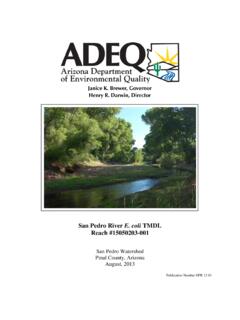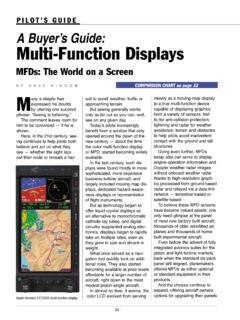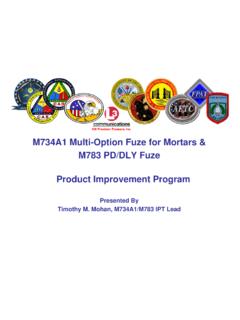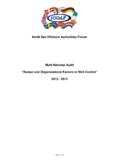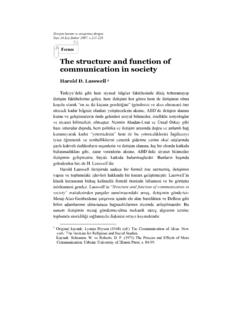Transcription of Method's 200.7, 200.8, & 200.9- Metals
1 1 Originator: Kenyon C. Carlson, Manager ADEQ QA Unit Contact For Information: Kenyon C. Carlson, Manager ADEQ QA Unit METHODS ; ; & I. SCOPE AND APPLICATION: Metals may be determined by atomic absorption (AA), inductively coupled plasma (ICP), or, with somewhat less precision and sensitivity by colorimetric methods. The absorption methods include flame and electrothermal techniques (graphite furnace atomic absorption). Flame methods are generally applicable at moderate concentration levels in both clean and complex matrix systems. Electrothermal methods (GFAA) can generally increase sensitivity if the matrix affects are not severe. Matrix modifiers frequently can compensate for many types of matrix effects.
2 ICP techniques are applicable over a broad linear range and are particularly sensitive for refractory elements. The detection limits for ICP methods are higher than for those for electrothermal methods. Colorimetric methods are applicable when interferences are known to exist within a particular method. This is a general purpose procedure for the collection of water samples for the analysis of Metals and trace elements in ground waters, surface waters, and drinking water supplies. This method is applicable to the following analytes: Chemical Abstract Services Analyte Registry Numbers (CASRN) Aluminum (Al) 7429-90-5 Antimony (Sb) 7440-36-0 Arsenic (As) 7440-38-2 Barium (Ba) 7440-39-3 Beryllium (Be) 7440-41-7 Boron (B) 7440-42-8 Cadmium (Cd) 7440-43-9 Calcium (Ca) 7440-70-2 Chromium (Cr) 7440-47-3 Cobalt (Co) 7440-48-4 2 Chemical Abstract Services Analyte Registry Numbers (CASRN) Copper (Cu) 7440-50-8 Iron (Fe) 7439-89-6 Lead (Pb) 7439-92-1 Lithium (Li) 7439-93-1 Magnesium (Mg) 7439-95-4 Manganese (Mn) 7439-96-5 Mercury (Hg) 7439-97-6 Molybdenum (Mo) 7439-98-7 Nickel (Ni) 7440-02-0 Phosphorous (P) 7723-14-0 Potassium (K) 7440-09-7 Selenium (Se)
3 7782-49-2 Silica (SiO2) 7631-86-9 Silver (Ag) 7440-22-4 Sodium (Na) 7440-23-5 Strontium (Sr) 7440-24-6 Thallium (Tl) 7440-28-0 Tin (Sn) 7440-31-5 Vanadium (Zn) 7440-66-6 II. REAGENTS: Nitric acid (ultra high purity grade) 1:1 dilution. Add 500 ml of concentrated ultra pure nitric acid to 400 ml of ASTM type I water (reagent water-- free of analytes) and dilute to a volume of 1 liter. III. MATERIALS: 1 liter (32 oz) high density polyethylene bottles with poly-foam lined screw on caps. pH indicator paper (low end) Latex gloves Paper towels & Kim Wipe napkins Plastic container for disposal of used pipette tips Disposable glass pipettes and rubber bulb.
4 Protective eyewear 3 IV. PROCEDURE: 1. Remove any attachments such as hoses, screens or aeration devices on the faucet. Inspect the faucet for anything that may fall into the sample container. 2. Open the tap and allow the system to flush for approximately 10 minutes. This should be sufficiently long enough to get a representative sample. 3. Remove the cap from the polyethylene container. Do not rinse the container as it has already been acid rinsed and may already contain acid as a preservative. 4. To fill, tip the bottle at about a 45 C angle into the stream of water. Slow the stream sufficiently so as to be able to anticipate when the bottle is nearly full and thus avoid over flowing.
5 Fill the bottle to the fill line or within inch of the top. This will allow enough space for mixing and the addition of any additional acid if required. 5. Remove the bottle from the flow and recap. Invert the container five times. 6. Place a pH indicator test strip on a dry opened paper towel. Remove the screw-on cap and obtain an aliquot of the sample using a glass pipette. Moisten the pH indicator test strip with the aliquot from the glass pipette and immediately flick the pH indicator test strip once using a sharp wrist motion to shake off the excess water. Compare the strip with the reference pH range. A determination must be made within 30 seconds. 7. If the pH is < 2, recap the bottle firmly, dry the sample bottle, attach the sample/laboratory label to the bottle and secure the chain of custody seal around the cap.
6 Record the results in field notebook and place the sample bottle in the ice chest. 8. If the pH is not < 2, add 3 ml of 1:1 nitric acid (HNO3), recap the bottle firmly and invert the bottle 5 times. 9. Place a pH indicator test strip on a dry opened paper towel. Remove the screw-on cap and obtain an aliquot of the sample using a glass pipette. Moisten the pH indicator test strip with the aliquot from the glass pipette and immediately flick the pH indicator test strip once using a sharp wrist motion to shake off the excess water. Compare the strip with the reference pH range. A determination must be made within 30 seconds. 10. If the pH is < 2, recap the bottle firmly, dry the sample bottle, attach the sample/laboratory label to the bottle and secure the chain of custody seal around the cap.
7 Record the results in field notebook and place the sample bottle in the ice chest to cool to 4 C. 4 IV. PROCEDURE (continued): 11. Continue the process of adding acid to the sample, recapping, mixing, and testing until the pH of the sample reaches a pH of < 2. Remember to note the amount of acid added to the water sample in the field notebook. V. SAMPLE TRANSPORT: After obtaining the water samples (in duplicate if necessary), attach the preprinted sample label onto the bottle(s) as well as the completed chain of custody seal around the plastic cap of each sample bottle. Place the sample bottle(s) into the ice chest for transport. The samples must be chilled and preserved at a temperature of 4 C and maintained at that temperature until analysis.
8 Always use chopped, grated, or dry ice when chilling the samples for transportation. Never use blue ice as the samples may not chill adequately. Field samples that will not be received at the laboratory on the day of collection must be packaged for shipment with sufficient ice to ensure they will be at 4 C upon arrival at the laboratory. Samples that cannot be acid preserved at the time of collection because of sampling limitations or transport restrictions should be acidified with nitric acid (HNO3) to a pH < 2 upon receipt in the laboratory and allowed to sit approximately sixteen hours. This waiting period is to allow any inorganic Metals to return back into solution in the event they may have precipitated or plated out along the inside of the sample container as a result of inadequate acidification at the time of collection.
9 VI. SAMPLE STORAGE: Store samples at 4 C until digested for analysis. VII. DEFINITIONS: A. Aliquot: A measured portion of a sample taken for analysis. B. Flame atomic absorption: A portion of the digested sample is directly introduced into a flame. The sample is atomized in the flame while the light from a hollow cathode ray lamp is directed through it. Some of the light is absorbed by the element in the sample and that amount of absorbance is used to calculate the concentration of the element in the original sample. C. Graphite furnace atomic absorption: A small amount of digested sample is placed in a graphite tube where it is dried and heated to very high temperatures.
10 Upon heating, the sample is atomized in the source light path where absorption takes place. 5 VII. DEFINITIONS (continued): D. Quantitative results are obtained by comparing sample absorbances to that of analytical standards analyzed in the same way E. Inductively coupled plasma: Unlike the AA procedures, ICP utilizes atomic emission to quantitate various elements. Just as with AA where each element has its own characteristic atomic absorption spectrum , each element undergoing ICP analysis has its own characteristic atomic emission spectrum and a unique set of wavelengths that it emits at very high temperatures. This is achieved by heating the sample using plasma, to high temperatures ( , 10,000 Kelvin), at which point the characteristic wavelengths are emitted.








